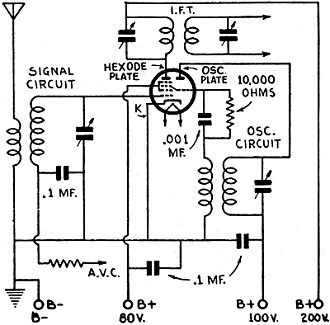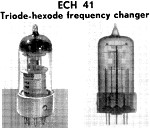|
February 1935 Short Wave Craft
 [Table
of Contents] [Table
of Contents]
Wax nostalgic about and learn from the history of early electronics. See articles
from Short Wave Craft,
published 1930 - 1936. All copyrights hereby acknowledged.
|
These 1930s vintage multi-component vacuum tubes were actually the first examples
of integrated circuits insofar as they incorporated two or more different types
of amplifiers, or amplifiers and diodes. Just as with semiconductor integrated circuits,
isolation between elements was a concern and necessitated additional screen grids
for that purpose. The triode hexode was developed specifically to solve the issue
of degenerative feedback squelching intended oscillations in the newfangled higher
frequency shortwave radio sets that were all the rage back in the day. It combined
a triode for the oscillator circuit and the hexode was the "frequency changer,"
aka mixer or downconverter.
The Triode Hexode - A New Tube
 Until recently, designers of short-wave equipment
have had to utilize tubes which were made for use on lower frequencies and make
the best of a bad situation. Until recently, designers of short-wave equipment
have had to utilize tubes which were made for use on lower frequencies and make
the best of a bad situation.
The demand for better parts - and especially tubes - has brought several new
tubes, such as the RCA "Acorn" tube into existence.
When the pentagrid-converter tube was first introduced, set builders hailed it
as the answer to all problems of superheterodyne construction. Here was a tube which
answered all the problems without introducing any new ones.
But like all other "cure-alls" the pentagrid tube also has its faults - among
which is a tendency to stop oscillating at high frequencies, above a certain critical
frequency - which limits its use in short-wave sets. This is caused by a feed-back
of energy from the oscillator plate (grid) to the control-grid, through the inter-electrode
capacity, for the shielding between these electrodes is necessarily imperfect.
This feed-back causes a degenerative effect which reduces the over-all gain of
the tube and on high frequencies, where the impedance of the inter-electrode capacity
is low, it actually stops the oscillator from functioning.
In order to overcome these disadvantages, a new electron-coupled frequency converter
or translator as it is sometimes called, has been designed in England. This new
tube was described in Wireless World.

Hook-up for the new English "Triode-Hexode" tube.
It consists of two separate tubes built into a single envelope - one a triode
and the other a hexode - hence the name. The hexode has six electrodes, a cathode,
a control-grid, two screen-grids, a coupling-grid and a plate. The control-grid
immediately surrounds the cathode and is itself surrounded by the first screen-grid.
The coupling-grid comes next and is separated from the plate by the second screen-grid.
The coupling-grid is connected internally to the triode (oscillator) grid. This
grid is surrounded by the triode plate, and the latter two elements form an entirely
separate tube, joined with the hexode only by the coupling-grid which provides the
desired electron coupling.
Variations in the oscillator plate voltage have no effect upon the screen and
plate currents of the hexode, and changes in the hexode screen, plate, or control-grid
voltages do not alter the oscillator plate current.
It will thus be seen that the triode-hexode offers important advantages over
other frequency changers in that, while it is non-radiating and can be controlled
from the A.V.C., it gives complete freedom from interaction between the signal and
oscillator circuits and also a lower level of background hiss. These points are
important in broadcast reception, but they are doubly so on short wave lengths.
Posted February 14, 2024
(updated from original
post on 6/26/2017)
|










 Until recently, designers of short-wave equipment
have had to utilize tubes which were made for use on lower frequencies and make
the best of a bad situation.
Until recently, designers of short-wave equipment
have had to utilize tubes which were made for use on lower frequencies and make
the best of a bad situation. 
